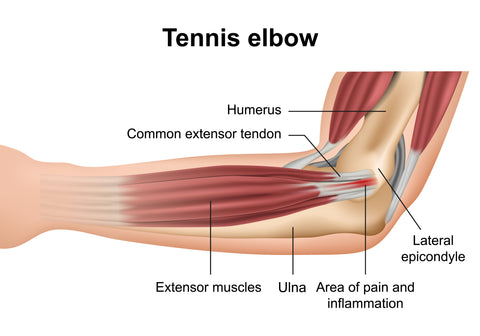Treating Lateral Elbow Pain - Vacuum Cupping
Lateral Elbow Pain is Often Associated with Trigger Points
Lateral elbow pain is frequently linked to trigger points in the elbow and forearm muscles, a problem that has become more common due to our sedentary and technology-based lifestyles. Hands-on therapists often experience tense and stiff forearm muscles, which exacerbates the condition.
Trigger points form as part of the body's protective mechanism to heal trauma by "switching off" around damaged tissue. If not properly managed, these points can become deep-seated, causing muscles to shorten, tighten, and lose efficiency. This can also increase sensory input to the nervous system, lowering the pain threshold and preventing full recovery. Essentially, untreated trigger points can worsen pain and hinder healing.

Latin, Lateral Epicondyle = Lateral Epicondylus; Extensor Carpi Radialis Brevis = Short Wrist Extender
Origin
Extensor Carpi Radialis Brevis: Lateral epicondyle of the humerus.
Extensor Carpi Ulnaris: Lateral epicondyle of the humerus and the posterior border of the ulna.
Insertion
Extensor Carpi Radialis Brevis: Base of the third metacarpal.
Extensor Carpi Ulnaris: Base of the fifth metacarpal.
Action
Extensor Carpi Radialis Brevis: Extends and abducts the wrist.
Extensor Carpi Ulnaris: Extends and adducts the wrist.
Nerve
Radial nerve (C6, C7, C8).
Basic Functional Movement: Examples include gripping objects, opening bottles, and shaking hands.
Pain Patterns:
Extensor Carpi Radialis Brevis: Pain 1-2 cm distal to its attachment on the lateral epicondyle, often implicated in lateral elbow pain.
Extensor Carpi Ulnaris: Trigger points in this muscle can also contribute to lateral elbow pain.
Indications
Conditions such as tennis elbow, golfer’s elbow, arthritis of the elbow or shoulder, chronic use of crutches or walking sticks, repetitive mechanical activities of the arms, racquet sports, aching pain over the front of the shoulder, and weakness in turning the palm face upward.
Causes
Repetitive motion injury, sports activities like tennis, repeated actions with the arm, lifting heavy objects with the palm upward, and playing musical instruments like the violin, drums, or guitar.
Differential Diagnosis
Radial nerve injury, ulnar neuropathy, and C7 neuropathy (cervical disc).
Connections
Related muscles and structures include the lateral head of the triceps, supinator, brachioradialis, extensor carpi radialis longus, and anterior deltoid.
Tennis Elbow
Tennis elbow, or lateral epicondylitis, often starts as a mild ache but can quickly become a severe problem, causing pain during activities like gripping, opening bottles, or shaking hands. The pain is frequently associated with trigger points in the muscles of the lateral epicondyle of the elbow, especially the extensor carpi radialis brevis tendon.
Understanding Tennis Elbow
While commonly referred to as lateral epicondylitis, tennis elbow is generally not an inflammatory condition. Microscopic examination shows angiofibroblastic degeneration and collagen disarray without signs of inflammation. It is most often due to repetitive micro-tears in the musculotendinous junction, particularly where the tendon meets the bone, an area that is relatively hypovascular. Light microscopy reveals an excess of fibroblasts and new blood vessels (angiogenesis), indicating chronic overuse and degeneration rather than acute inflammation.
Trigger Point Treatment Techniques
Effective treatments include deep tissue massage therapy, muscle stretching, heat and ice, kinesio taping, dry needling (medical acupuncture), and vacuum or static cupping. These treatments aim to release the trigger points, improve muscle flexibility, and reduce pain.
General Advice to Clients
Clients should review their arm positions during repetitive manual work and take regular breaks. Using a new tennis racquet or widening the grip can help, as well as avoiding overhead activities. It is also important to maintain proper ergonomics during daily activities to prevent strain on the elbow and forearm muscles.
Self Help
Self-massage techniques using a hard ball or pressure tool can be beneficial. Stretching exercises are excellent for disabling trigger points in arm muscles. Regular self-care routines, including stretching and strengthening exercises, can help maintain muscle health and prevent the recurrence of trigger points.
About Niel Asher Education
Niel Asher Education (NAT Global Campus) is a globally recognised provider of high-quality professional learning for hands-on health and movement practitioners. Through an extensive catalogue of expert-led online courses, NAT delivers continuing education for massage therapists, supporting both newly qualified and highly experienced professionals with practical, clinically relevant training designed for real-world practice.
Beyond massage therapy, Niel Asher Education offers comprehensive continuing education for physical therapists, continuing education for athletic trainers, continuing education for chiropractors, and continuing education for rehabilitation professionals working across a wide range of clinical, sports, and wellness environments. Courses span manual therapy, movement, rehabilitation, pain management, integrative therapies, and practitioner self-care, with content presented by respected educators and clinicians from around the world.
Known for its high production values and practitioner-focused approach, Niel Asher Education emphasises clarity, practical application, and professional integrity. Its online learning model allows practitioners to study at their own pace while earning recognised certificates and maintaining ongoing professional development requirements, making continuing education accessible regardless of location or schedule.
Through partnerships with leading educational platforms and organisations worldwide, Niel Asher Education continues to expand access to trusted, high-quality continuing education for massage therapists, continuing education for physical therapists, continuing education for athletic trainers, continuing education for chiropractors, and continuing education for rehabilitation professionals, supporting lifelong learning and professional excellence across the global therapy community.

Continuing Professional Education
Looking for Massage Therapy CEUs, PT and ATC continuing education, chiropractic CE, or advanced manual therapy training? Explore our evidence-based online courses designed for hands-on professionals.


















